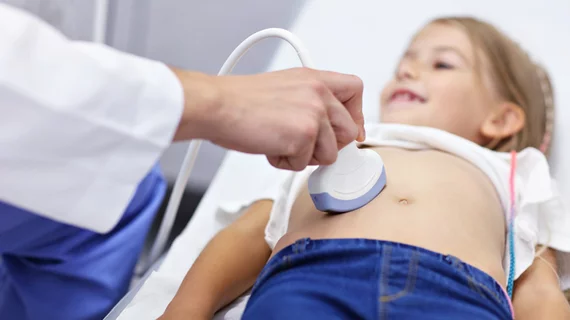Radiologists, sonographers achieve identical outcomes using first-line ultrasound for appendicitis
Whether a radiologist or sonographer performs the initial ultrasound in children with suspected appendicitis doesn’t matter; their skill differences did not significantly alter clinical outcomes, according to new findings.
There’s well-known variability between these two specialists’ performance and interpretation skills, yet those discrepancies did not independently predict hospital admission, surgical consult, the performance of an appendectomy, or 30-day hospital readmission, experts reported Friday in JACR.
This may indicate individual sonographers and rads all meet the standard of care, or that safety nets identify and correct most divergences in care, Leah. A. Gilligan, MD, with the Department of Radiology at Cincinnati Children’s Hospital Medical Center, and colleagues explained.
Either way, the authors said their results are important given that ultrasound is used as a first-line test for suspected appendicitis in most pediatric hospitals.
“Our study has shown that individual sonographers and radiologists are clinically indistinguishable in the setting of suspected pediatric acute appendicitis and that any differences in appendix ultrasound performance are not statistically associated with differences in important clinical outcomes,” Gilligan and co-authors added April 30.
For their study, the group compared 31 sonographers to the same number of radiologists. The final tally included 9,283 appendix ultrasounds performed by sonographers and interpreted by rads. Patients were all 18 years or younger who came to the emergency department with symptoms suggestive of appendicitis.
After analyzing a decades’ worth of data, the mean admission frequency was nearly identical between radiologists and sonographers (33.5% vs. 34%, respectively). The mean number of appendectomies per specialist, meanwhile, was exactly the same at 20.3%.
And while individual provider differences didn’t predict clinical outcomes, they discovered a few factors that did.
Multivariate predictors of hospital admission included patient temperature, white blood cell count, male gender, and if imaging was performed at the main hospital compared to a satellite center, among other factors.
Appendectomy predictors included patient weight, white blood cell count, abnormal tenderness with ultrasound transducer compression, and the presence of appendicitis on ultrasound.
Gilligan and colleagues noted their results may not be generalizable to smaller pediatric radiology departments or children imaged in adult facilities, but they would expect similar findings for sonographers and rads with comparable training and experience.
Read the entire study in the Journal of the American College of Radiology.

